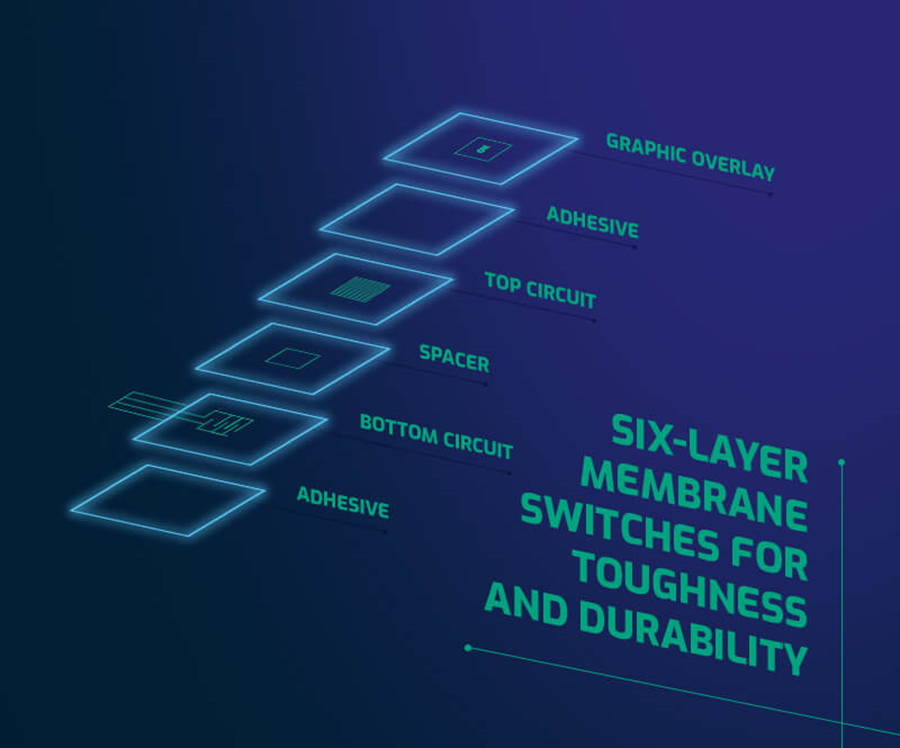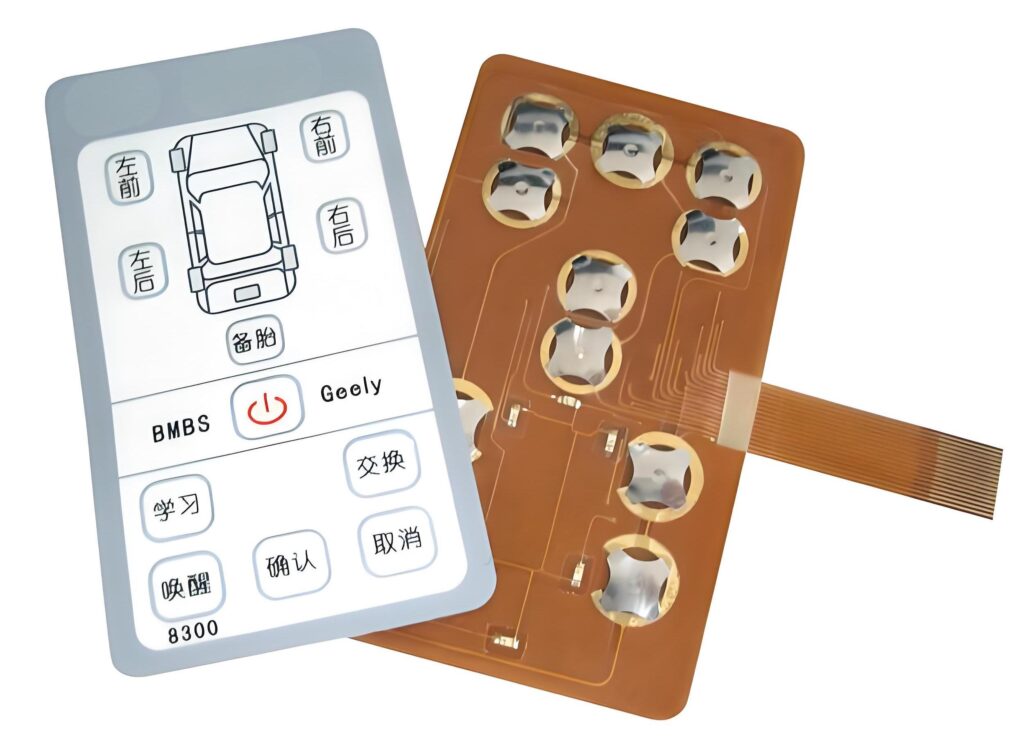All Concerning Membrane layer Change: A Comprehensive Guide for Beginners
Membrane layer buttons are important components in contemporary electronics, offering an one-of-a-kind interface for customer communication - membrane switch. Their split construction, consisting of overlays and conductive traces, offers functionality and resilience. Unlike typical mechanical switches, membrane layer switches present a streamlined design and personalized options. Recognizing their vital features and advantages can transform item design. Nonetheless, the ins and outs of their application and layout considerations require more exploration
What Is a Membrane Change?
A membrane button is a type of electrical button that contains a versatile membrane layer layered over a published circuit card. This layout permits a compact and smooth user interface, usually utilized in different digital devices. Membrane switches are commonly discovered in consumer appliances, medical devices, and industrial machinery because of their toughness and resistance to environmental factors.The building normally consists of numerous layers, such as graphic overlays and sticky support, which supply responsive responses and safeguard the circuitry beneath. The operation of a membrane button is launched when stress is put on the surface area, finishing an electrical circuit.These switches are valued for their flexibility, enabling customized styles and published graphics that satisfy certain individual interfaces. Their inconspicuous nature minimizes room needs, making them excellent for applications where traditional buttons might not fit. Overall, membrane layer buttons use a visual and practical option for contemporary electronic tools.
Trick Elements of Membrane Layer Changes
Membrane layer switches over consist of a number of essential components that contribute to their functionality and efficiency. The leading layer, called the overlay, offers the individual interface and is typically printed with signs or graphics. Beneath the overlay exists a spacer layer, which divides the conductive components and protects against inadvertent activation. The following vital part is the graphic layer, which enhances visual appeals and ensures the toughness of the design.Conductive traces, usually made from materials like silver or carbon, are published on the circuit layer. When pressure is related to the overlay, these traces enter get in touch with, completing the circuit. In addition, a backing layer offers architectural support and can be made from products such as polyester or polycarbonate. Together, these parts produce a reliable, user-friendly interface suitable for numerous applications, from home devices to industrial tools. Comprehending these elements is necessary for anybody curious about membrane button technology.
Exactly How Membrane Layer Switches Work
Understanding just how membrane layer switches feature is important for valuing their widespread use in numerous tools. A membrane layer button operates with a collection of layers, consisting of a graphic overlay, spacer, and a circuit layer. When stress is related to the overlay, it compresses the spacer layer, enabling the circuit layer to make contact and complete an electric circuit. This activity sends out a signal to the device, triggering a response, such as turning on a light or turning on a function.Membrane switches over can be designed with different features, consisting of tactile comments, backlighting, and customized graphics, boosting user interaction. Their construction enables for a covered design, safeguarding the interior elements from dirt, moisture, and contaminants. This toughness makes them ideal for varied applications, from customer electronic devices to industrial equipment. Generally, the simpleness and efficiency of membrane layer switches over contribute to their appeal in modern-day innovation.
Advantages of Membrane Switches Mechanical Switches
While mechanical buttons have actually long been a staple in many gadgets, membrane switches deal distinctive benefits that make them increasingly appealing. One significant advantage is their slim account, permitting for even more portable styles and higher versatility in product advancement. Furthermore, membrane switches over feature a consistent surface area, which improves aesthetic appeal and streamlines cleansing, making them ideal for settings where hygiene is critical.Another advantage is their resistance to dust and moisture. Unlike mechanical buttons, which can be jeopardized by environmental variables, membrane layer buttons supply a sealed user interface that safeguards versus pollutants - membrane switch. Additionally, membrane layer switches commonly have a longer life-span because of fewer relocating parts, leading to enhanced durability and reliability.Cost-effectiveness is additionally a notable advantage, as membrane buttons can be created in mass with lower manufacturing expenses. These variables integrate to position membrane buttons as a functional alternative to standard mechanical choices in different applications
Typical Applications of Membrane Changes
Membrane layer switches are commonly utilized in various markets, especially in consumer electronic devices and commercial control board. In consumer devices, they offer a sleek, user-friendly interface, while in commercial setups, they enhance sturdiness and capability. Comprehending these applications highlights the flexibility and usefulness of membrane buttons in modern technology.
Customer Electronic Devices Instruments
As consumer electronic devices remain to develop, membrane switches have become a popular selection for a range of tools because of their convenience and sleek style. These switches are typically located in smart devices, tablets, and remotes, where room is minimal and visual appeals matter. Their low profile and personalized layouts permit suppliers to create easy to use user interfaces that enhance the overall user experience. Additionally, membrane switches are typically made use of in appliances such as microwaves and coffee machine, giving intuitive control options while resisting moisture and dirt. The toughness and dependability of membrane layer switches make them ideal for day-to-day consumer items, ensuring longevity and constant performance. Overall, their integration in consumer electronic devices shows a blend of capability and contemporary layout.
Industrial Control Panels
The applications of membrane layer switches over extend beyond consumer electronic devices, finding substantial usage in commercial control panels. These switches are favored for their toughness and resistance to rough environments, making them optimal for producing and process control setups. They offer a dependable user interface for drivers to control equipment, monitor procedures, and readjust settings. Membrane layer switches can be personalized to suit specific operational demands, integrating attributes like backlighting and tactile feedback, improving user experience. Their low-profile layout permits integration right into numerous devices, while their capacity to endure spills, dust, and extreme temperature levels guarantees durability. On the whole, membrane layer buttons contribute to secure and reliable procedure in industrial applications, showing their versatility and efficiency sought after settings.
Considerations for Creating Membrane Layer Switches
When developing membrane layer buttons, selecting the ideal products is necessary to ensure sturdiness and capability. In addition, recognizing layer setup strategies can considerably affect the button's performance and customer experience. These considerations play a crucial role in developing reliable and effective membrane layer switch designs.
Material Choice Importance
Material visit this page selection plays a vital function in the design and functionality of membrane switches. The picked products directly affect the button's durability, responsive feedback, and general visual. Secret considerations include the substrate, which need to supply architectural honesty while permitting for adaptability, and the visuals overlay, which needs to be immune to wear and ecological variables. Conductive products must assure reputable electric efficiency, while adhesives have to use solid bonding without jeopardizing the switch's procedure. In addition, compatibility with making processes and end-user environments is essential; products have to hold up against differing temperatures, moisture levels, and chemical direct exposure. Eventually, appropriate product choice not just enhances the membrane layer switch's efficiency however also contributes to its longevity and individual complete satisfaction, making it a crucial aspect of the design procedure.

Layer Setup Strategies

Often Asked Questions
The Length Of Time Do Membrane Layer Changes Typically Last?
Membrane buttons generally have a life-span of 1 to 5 million cycles, depending upon use and environmental conditions. Variables such as design quality and operating frequency substantially influence their sturdiness and total efficiency longevity.

Can Membrane Layer Switches Be Customized for Specific Layouts?
Membrane layer switches can indeed be personalized to suit details layouts, permitting varied forms, colors, and functionalities. This versatility allows suppliers to customize these switches to fulfill special aesthetic and functional needs successfully.
What Materials Are Made Use Of in Membrane Switch Building And Construction?
Membrane switches are typically built using products such as polyester, polycarbonate, and glue layers. These products offer adaptability, resilience, and resistance to environmental variables, ensuring the switches operate effectively in different applications and conditions.
Are Membrane Layer Switches Immune or water-proof to Moisture?
Membrane buttons can be made to be moisture-resistant, utilizing specialized materials and layers. Their waterproof capabilities depend on construction quality and particular applications, making it crucial to evaluate requirements for perfect performance in different settings.
How Are Membrane Switches Over Fixed if Damaged?
Fixing broken membrane layer switches over commonly entails changing the impacted layer or circuit. Professionals might additionally use conductive adhesive or use specialized repair kits, guaranteeing functionality is restored without full replacement of the entire switch assembly. Unlike traditional mechanical buttons, membrane switches offer a Learn More streamlined layout and adjustable options. A membrane layer switch is a kind of electrical switch that is composed of a versatile membrane layered over a published circuit board. The operation of a membrane layer switch is launched when stress is applied to the surface area, completing an electrical circuit.These switches are valued for their convenience, allowing customized layouts and printed graphics that provide to particular customer interfaces. While mechanical switches have actually long been a staple in lots of devices, membrane switches over offer distinctive advantages that make them significantly appealing. like this Membrane switches commonly have a longer life expectancy due to less moving components, resulting in enhanced resilience and reliability.Cost-effectiveness is additionally a remarkable advantage, as membrane layer switches can be produced in bulk with lower manufacturing expenses.